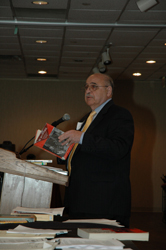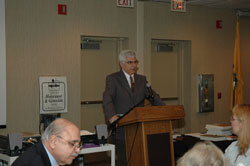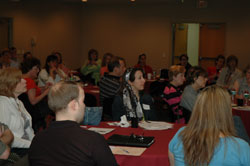- About Ramapo
- Academics
- Admissions & Aid
- Student Life
- Athletics
- Alumni
- Arts & Community
- Quick Links
- Apply
- Visit
- Give
Using Primary Sources on the Holocaust and Genocide Theme of Gumpert Workshop
(PDF) (DOC) (JPG)May 21, 2009

Dr. Dennis Papazian, Professor Emeritus of History at the University of Michigan-Dearborn.
(Mahwah) – “Utilizing Primary Sources about the Holocaust and Genocide in the Classroom”was the title of a Gumpert Teachers’ Workshop held at Ramapo College on MAY 21, 2009 and sponsored by the Gross Center for Holocaust and Genocide Studies in cooperation with the New Jersey State Commission on Holocaust Education.
Born of a fall meeting of the northern group of New Jersey’s Holocaust organizations, the all-day workshop was conceived to assist middle and high school teachers to apply the best practices in using the wide array of available primary sources to help students grasp some of the enormity of the Holocaust and similar tragedies, such as the Armenian, Cambodian, Rwandan and Darfur genocides. In making validated historical enquiry an integral part of the classroom experience, students will acquire a more in-depth and nuanced knowledge about the forces and processes that brought about these catastrophes in the first place. The overall goal is for students to obtain an understanding of the critical issues of discrimination, citizenship, activism and human rights, so as to prevent similar events from occurring in the future.
Welcoming workshop participants on behalf of Ramapo College was Dr. Hassan Nejad, dean of its School of Humanities and Global Studies. In his view, the loss of life in the Twentieth Century through genocide and the litany of human rights abuses places a heavy and special burden on the shoulders of educators. They must impart this tragic history in such a way as to have a hope of building a better tomorrow. Dr. Paul Winker, executive director of the New Jersey State Commission on Holocaust Education, further reiterated this theme in explaining the genesis of the workshop and highlighting its objectives.
The lead presentation was by Dr. Michael A. Riff, director of the Gross Center for Holocaust and Genocide Studies, who outlined the objectives, issues and opportunities presented by making the examination of primary source materials an integral part of the classroom experience. This has been made chiefly possible, Riff emphasized, through the availability of archival material of various types on the Internet. One of the clear advantages of having documentary evidence easily available is being able to counter efforts of deniers. Their claims cannot withstand the burden of presenting incontrovertible proof to students that tragedies like the Armenian Genocide and the Holocaust actually did occur.
While not discounting the importance of documentary and photographic evidence in telling the story of the Holocaust, Barbara Wind, who spoke next and is Director of the Holocaust Council of MetroWest, made a strong case for “Eyewitnesses as Primary Sources.” Based on her program’s model of “Survivors Speak,” trained experts, or moderators, are paired with survivors to enable them to tell their stories to students in as accurate and coherent a manner as possible. Eyewitnesses, who may also include liberators and bystanders, are instructed on the need to be concise, use appropriate terminology and avoid graphic details, sarcastic humor, and leave the general historical narrative to the professionals.
Not only the abundance of documentary and photographic evidence on various Internet sites, but also the publication of several new collections of archival sources is making it impossible to continue denying the Armenian Genocide. That was the main message that Dr. Dennis Papazian, Professor Emeritus of History at the University of Michigan-Dearborn and a member of the New Jersey State Commission on Holocaust Education, delivered in his talk “An Abundance of Proof: Archival Evidence and the Armenian Genocide.” Most recently, for example, the accounts of German diplomatic and military officials stationed in the Ottoman Empire have become more accessible and are being translated into English. By the same token, as Papazian showed, some Turkish historians have courageously published the records of the financial authorities and other bodies that lay to rest the official contention that Armenian citizens of the Ottoman Empire were not forcibly stripped of their property and expelled from their ancestral homes. And, as he pointed out, there are also the voluminous reports of U.S. officials stationed in Turkey, most of them in book form, which confirm the Genocide. The most important is Ambassador Morgenthau’s Story by Henry Morgenthau, the American Ambassador to Ottoman Turkey.
Two more presentations followed lunch, which was provided thanks to a generous grant from the Gumpert Foundation that also supports the Center’s other activities. The first was by Toby Kansagor, supervisor of Social Studies and director of REACH (the acronym of the districts talents and gifted program: Reach, Explore Academic and Creative Heights) program in the Hillsborough School District. Entitled “Is a picture worth 1,000 words?” her emphasis was on the importance of reading images relating to the Holocaust and other genocides as texts that have to be analyzed and deconstructed to be optimally useful for students. In addition to photographs, Kansagor used posters and excerpts from children’s books and games to point the way forward for teachers in the classroom.
The final presenter was Florette Lynn, a retired school librarian in the Hawthorne School District, whose talk, “Smashing the Stereotypes: The Role of the Yizkor Book” illuminated the possibilities of bringing the experience of Eastern European Jews before and during the Holocaust into the classroom.
Judging by participants’ written evaluations and later feedback, attendees found attending the workshop a valuable experience that they were eager to share with colleagues back in their home districts.

Dr. Hassan Nejad, dean of SSHGS in welcoming participants drew attention to role of Human Rights and Genocide education in helping to overcome the failings of the last century.

“Utilizing Primary Sources about the Holocaust and Genocide in the Classroom”
E-News Archives
| 2023 | 2022 | 2021 | 2019 | 2018 | 2017 | 2016 | 2015 | 2014 | 2013 | 2012 | 2011 | 2010 | 2009 | 2008 | 2007 |Copyright ©2024 Ramapo College Of New Jersey. Statements And Policies. Contact Webmaster.

Follow Us!